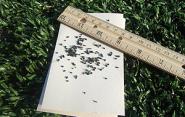Study Led By Gaboury Benoit Looks At Chemicals In Synthetic Playing Surfaces

The history of artificial playing surfaces is one fraught with controversy. Witness the latest outcry over FIFA’s decision to use artificial turf for the recent World Cup Women’s tournament.
 And when Astroturf was installed into the Houston Astrodome in 1960 – the first significant use of artificial playing surface - it was hardly given a unanimous welcome.
And when Astroturf was installed into the Houston Astrodome in 1960 – the first significant use of artificial playing surface - it was hardly given a unanimous welcome.
On a more local level, synthetic surfaces on playgrounds have prompted concerns among parents. Providing a softer surface than ground, it’s designed to prevent injuries from falls. But questions about the toxicity of the chemicals involved have persisted.
A new study led by Yale’s Gaboury Benoit, Professor of Environmental Chemistry and Engineering, could add to those concerns. It looks at the chemical makeup of rubber tire infill - made from recycled shreds of old tire - and rubber tire mulch, also made from recycled rubber tires. Both are commonly used in the synthetic surfaces of playgrounds. Environment and Human Health Inc. (EHHI), a Connecticut-based advocacy group, commissioned the study.
The researchers looked at five new samples of crumb rubber tire infill, and nine new samples of rubber mulch. One of the study’s findings is that of the 96 chemicals detected, almost half of them had no toxicity screenings to determine their health effects. The other chemicals underwent incomplete toxicity assessments. And of those, 20 percent are considered probable carcinogens. Additionally, 40 percent are found to be irritants causing problems for either breathing, the skin or the eyes.
(Image of synthetic turf courtesy of Environment and Human Health Inc.)

